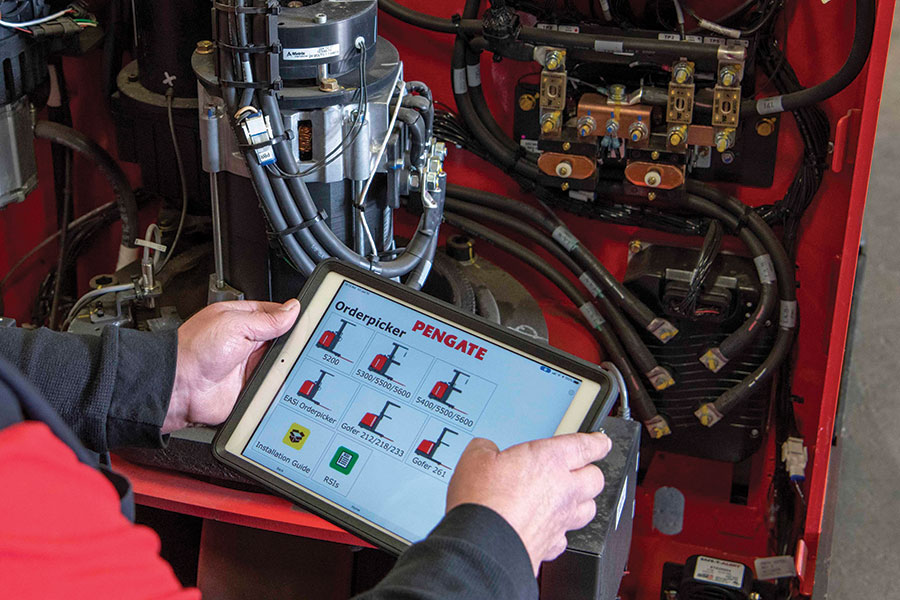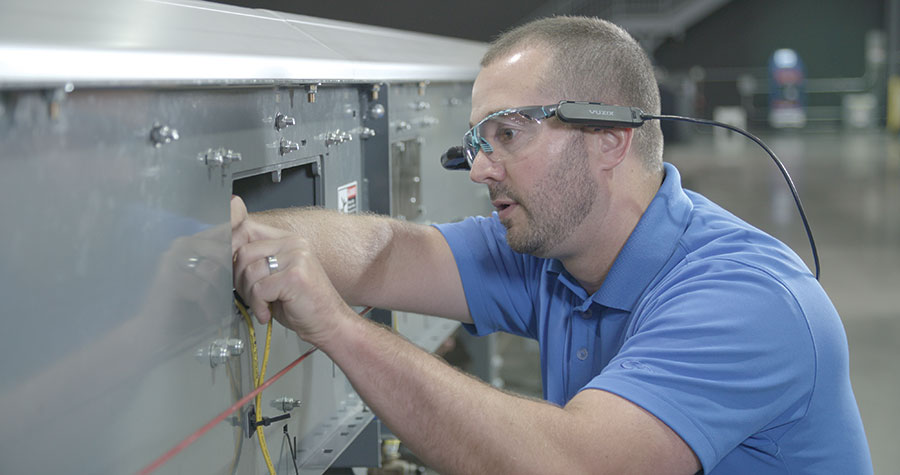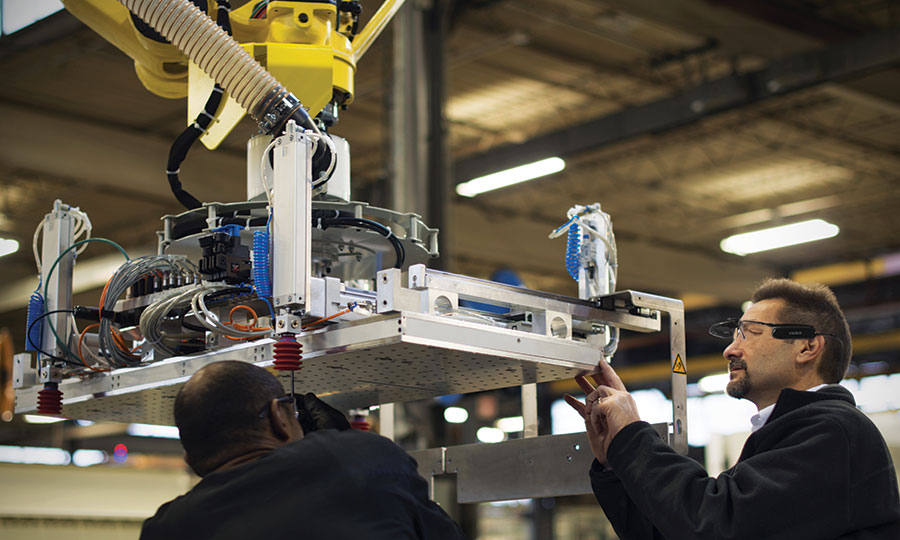Maintaining your MRO team during Covid
For maintenance teams, the pandemic is about much more than just PPE and protocols. More complete data, virtual meetings, tightly focused service calls and personal support for everyone on the team are the essential ingredients for success.

From the Issue of
Modern Materials Handling
The world wasn’t built for Covid. So, this is a time of great adaptation for MRO teams and their activities. In fact, the MRO world, in general, is under duress that it’s not used to.
“MRO in a pandemic is a little bit awkward,” says Swisslog’s Royden Edwards, director of services. “People know they have to adapt, but it has taken some time for all of us to fully understand just how big a statement that is,” he adds.
Talking to him and several others knee deep in all this makes it clear just how much Covid has affected MRO operations. The effects range from the procedures needed on a service call to how long a call takes. It even includes finding windows when technicians can do their job. And, the personal side of techs during the virus is not to be underestimated either. Here’s what several experts had to say about it all.
The basics have changed
The first step, of course, was just understanding what was happening to us. It became clear early on that almost nothing was linear and still isn’t in some ways.
“The changes at first were so dramatic,” says Edwards. “But by May, a lot of what was new just a couple of months before was now fairly common,” he adds.
“This would all be a whole lot easier if there were more stability out there. The first few months were challenging, but we probably have it 85% down now. But this pandemic is so dynamic that we’re still making accommodations with great frequency,” says John Rosenberger, Raymond’s director of iWarehouse gateway and global telematics.
There is a notable list of what is shifting.
Consider travel to a facility and state requirements. For instance, Connecticut decided in late October to place restrictions on people arriving from Massachusetts. Meanwhile, Connecticut did not place such restrictions on people from New York and New Jersey, saying the tri-state area is a region. To say the least, restrictions such as those can limit the mobility of techs who cross state lines on a daily basis.
There’s also the matter of scheduling the techs themselves. “Something as simple as PTO (paid time off) or more complicated such as the need for a tech to quarantine for 14 days afterward can create a scheduling nightmare,” says Johnny Zimmerman, national service manager for the United States at OPEX.
Then, there’s the matter of the call itself. Was it scheduled and pre-approved by the site people? What are their protocols for entering the building and working in it? What sanitization requirements do they have? What are the social distancing requirements while the work is being done? What tools does the tech need to sanitize after the call and before the next? And, that’s only a partial list.
Working differently
All of this has fundamentally changed how techs work.
The call itself is just different. It starts with PPE. But it gets more troublesome with something as simple as having to yell through the mask just to be heard. Then there’s the matter of observing all the various protocols, many of which differ from company to company. Others say the maintenance function in and of itself is collaborative and that aspect has changed substantially with social distancing.

However, collaboration has not gone away. Instead, it has taken on a different look. Side-by-side collaboration on site has been replaced by virtual collaboration often before the tech visits the facility. “Communication is still critical and is virtual far more frequently, allowing people to share data upfront,” says Rick Walter, program manager at Synovos.
Rosenberger says that for lift trucks, telematics are key. Using a range of operating data about the condition of various components on the truck, pre-identifies problem areas. “These days it’s critical to leverage data to create a maintenance baseline and to build on that. Otherwise, people will spend way too much time putting out fires every day,” adds Rosenberger.
It holds true for systems, too, says Diane Blair, director of field operations at Honeywell Intelligrated. “If you’ve had 17 calls about a conveyor V-belt in the past four months, that’s an important early indicator of what the tech will need to do on site,” she says.
Rosenberger says the combination of all changes due to the pandemic has extended the average lift truck call by nearly 70% from 1.5 hours to 2.5 hours in many parts of the country. And maintenance of automated systems similarly requires more time, says Blair.
Finding time for maintenance
This brings up another key point. When exactly is there time to do maintenance during Covid?
Many facilities initially shut down for an extended period are now running 24/7 to make up for lost time. Or, as Ken Ruehrdanz, manager of distribution systems market at Dematic, explains, “extreme system uptime is mandatory. Downtime is unacceptable. Reactive support may not be satisfactory anymore.”
What’s a tech team manager to do? Yes, the experts say, it comes back to the data that Rosenberger and Blair mentioned earlier.
Ruehrdanz reinforces their comments by saying, “system maintenance must be more proactive and predictive. Supervisors need to make smarter decisions to increase system uptime. Condition monitoring software and controls provide real-time visibility and insight into the health and performance of automated systems.”
Edwards of Swisslog says people “are making an effort to embrace monitoring technology. People know they have to adapt, and this is a highly effective way to get data before the techs go in, allowing them to have as small a footprint as possible in terms of time and equipment downtime due to preventative maintenance.”
“Having more data also tends to focus the mind,” says Blair. In turn, that allows techs to hone in on the equipment that requires attention and complete the necessary tasks in a tight time frame. “The real trick is to focus on the primary components that, if they fail, will put the system in danger. Techs have to look holistically at the assets in a facility and ensure the top priority items are taken care of first,” she adds.
None of what was just said directly answers the question: When is there time for maintenance? There is no easy answer to that one. In some cases, says Zimmerman of Opex, it comes down to actual negotiations as to when maintenance can be done and how long it can take. He and others agree that there is no longer time for five hours of preventative maintenance daily in a pandemic. Ultimately, that requires more and better communication.
More data is part of that communication. Virtual meetings, too. Business continuity plans need to be formulated and discussed across companies including techs to anticipate what needs to be done in the face of a moment of crisis as opposed to a general pandemic crisis. In short, when it comes to all the restrictions of a pandemic, it is probably impossible to over communicate.
Just ask Larry Jones, vice president of operations at Conveyco. Soon after the pandemic arrived, he had to build a team of nine techs to maintain a new 1-million-square-foot e-commerce DC. “Communication was essential in so many directions. Between facility management and myself and the techs. People have assimilated well and everyone is listening to everyone else, making this startup manageable even in a pandemic,” Jones says.

The techs themselves
MRO during Covid is about a lot more than everything that has been said so far. It’s above all else about the techs themselves.
“Techs can’t feel like they are on an island,” says Zimmerman of OPEX. Supporting them with much more than just PPE and protocols is essential. “They have to feel safe, realize their concerns are my concerns, and they have an arsenal of support,” he adds.
Dave Beres, director of field service at OPEX, says that “managers have to be all in just like the techs do at each facility they visit. Ultimately, MRO during a pandemic is about all of the people on the MRO team. There’s just no other way to do it.”
That said, an emotional toll exists, says Edwards. He explains that with the shift from side-by-side teamwork to social distancing and virtual meetings a tech team culture can suffer. “However, we have to focus every day on building the tech team in a new environment that still relies on the same teamwork culture of before,” he says.
“Transparency is key,” says Blair. She says it’s a two-way street. Techs need to know what their managers are faced with on the job just as managers need to know what techs are faced with off the job. “MRO teams need to know how important they are to the facilities they visit. At the same time, they can’t be expected to work 80 hours a week. They have families they have to protect from the virus and care for too.”
When all is said and done, “people are adapting. If this is the new norm we will find ways to get by,” says Edwards. “These are the challenges we were asked to adapt to and we will.”
Companies mentioned in this article:

Article Topics
MRO News & Resources
Avidbots showcases autonomous cleaning robots Traka exhibits modular lockers MRO Survey: Finding and keeping the best technicians Maintenance, Repair and Operations: Understanding the true condition of the equipment Newly formed Bison combines AMETEK DFS and Bison Gear and Engineering Corp. Building (and maintaining) your maintenance, repair and operations (MRO) tech workforce The power side of lift truck battery and charger maintenance More MROLatest in Materials Handling
Registration open for Pack Expo International 2024 Walmart chooses Swisslog AS/RS and software for third milk processing facility NetLogistik partners with Vuzix subsidiary Moviynt to offer mobility solutions for warehouses Materials Handling Robotics: The new world of heterogeneous robotic integration BSLBATT is looking for new distributors and resellers worldwide Lucas Watson appointed CSO for Körber’s Parcel Logistics business in North America Hyster recognizes Dealers of Distinction for 2023 More Materials HandlingAbout the Author
Subscribe to Materials Handling Magazine

Find out what the world's most innovative companies are doing to improve productivity in their plants and distribution centers.
Start your FREE subscription today.
April 2024 Modern Materials Handling

Latest Resources










